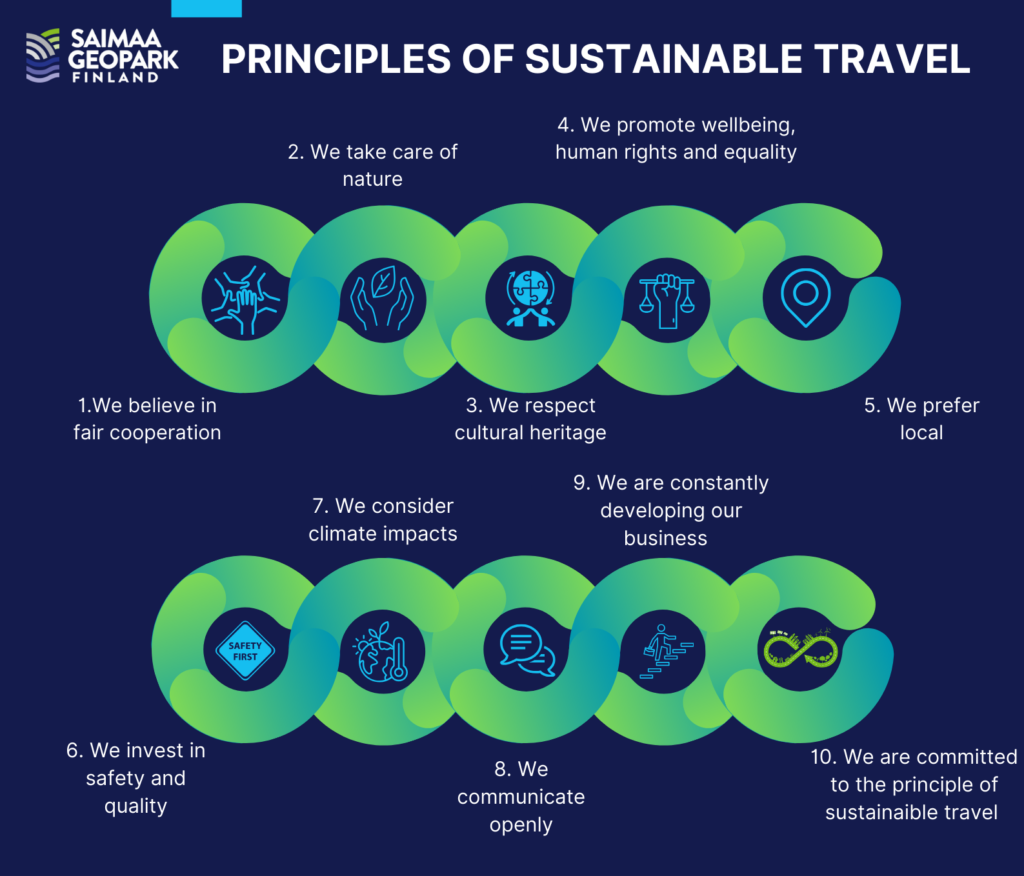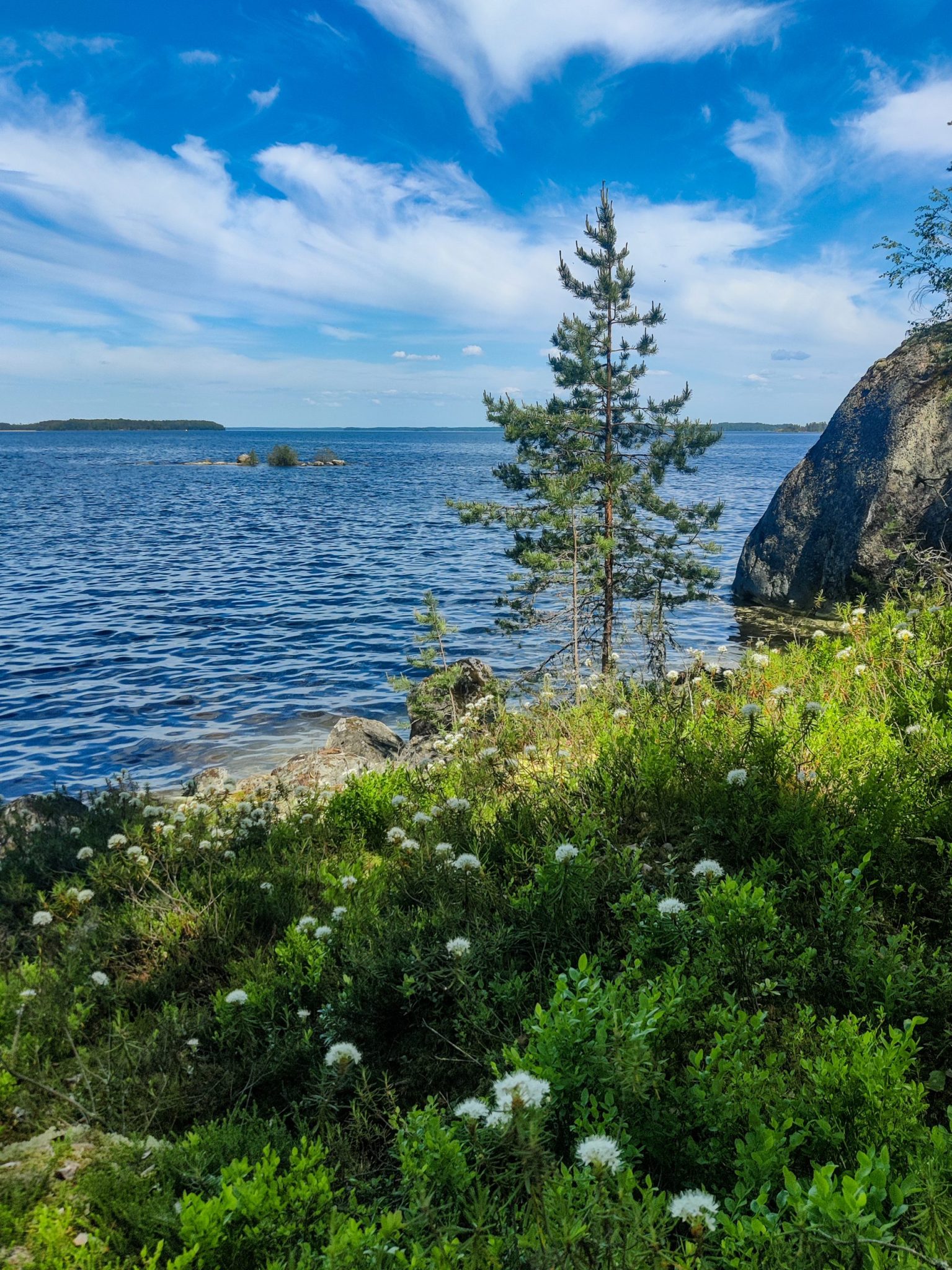PRINCIPLES OF SUSTAINABLE TOURISM
According to the UN World Tourism Organization, the term sustainable tourism can be defined as: “Tourism that takes full account of its current and future economic, social and environmental impacts, addressing the needs of visitors, the industry, the environment and host communities”. Global development of sustainable tourism is closely connected to the 2030 Agenda for Sustainable Development and its heart, which consists of the 17 Sustainable Development Goals (SDGs) adopted by all United Nations Member States in 2015.
All members of the UNESCO Global Geoparks network give their contribution to the Sustainable Development Goals. This also applies to Saimaa Geopark which received UNESCO Global Geopark status in 2021. Please see further information on the UNESCO Global Geoparks.
we are also COMMIT TO FOLLOWING THE PRINCIPLES OF SUSTAINABLE Travel SET BY VISIT FINLAND

RESPONSIBILITY
The definition of responsible tourism is based on the same principles as sustainable tourism, yet, it is not the exact same thing. Sustainability is a goal that can be achieved only by people taking responsibility together with each other. Responsible tourism is about taking responsibility and acting to make tourism sustainable.
The global travel market has adopted the Cape Town Declaration definition of responsible tourism which encourages the industry to take responsibility for making tourism more sustainable and demonstrate their responsibility.
A responsible tourist can make a difference with their choices e.g. by finding out about the destination and different options already before the trip. Responsible service providers can make the decision-making easier by offering information and guidance.
A graduate of tourism studies programme, Anna Tiippana, surveyed company owners’ thoughts on responsible tourism in Saimaa Geopark area (in Finnish) in her thesis. According to the results, the majority of entrepreneurs in tourism are willing to invest in responsibility in the future. When communicating about responsibility, the companies want to concretise the topic and emphasise the values behind responsible actions. The aim is to develop less consuming services, prolong the visitors’ stay in the destination, and use renewable natural resources when possible.
When it comes to regional development of tourism, Saimaa Geopark aims to obtain the role of sustainable tourism expert, coordinating and collecting together different actors of the region.
CIRCULAR ECONOMY
When moving to circular economy, consumption is no longer based on mass-production of more and more goods, and neither on owning things. Instead, it is based on using services – sharing, renting and recycling. Materials are not destroyed at the end of their useful life, but used to make new products over and over again. Circular economy means that the production and consumption chains work efficiently and the amount of waste is reduced to the minimum. The change towards a circular economy is necessary in order to protect our limited natural resources and to ensure sustainable development.
Visitors can explore Saimaa Geopark and its sites by using low-carbon means of transportation, enjoying immaterial experiences in the beautiful natural surroundings, and finding rental services for vehicles and equipment. Saimaa Geopark also encourages and advises visitors to leave the environment litter-free. The region’s active NGOs take care of the maintenance of toilets and rubbish bins in the harbours and in campsites. This enables geopark users to do boating, hiking and other outdoor activities in clean nature and in a sustainable and responsible way.
AN ACTION PLAN FOR THE QUALITY DEVELOPMENT AND SUSTAINABLE TOURISM OF SAIMAA GEOPARK
Taking sustainability into account is the basis of geology-based traveling, since it is implemented in areas that are environmentally sensitive and where traveling groups expect services to be provided responsibly.
There are also several actors and stakeholders in the Saimaa Geopark area, such as companies, associations and actors of the public sector such as municipalities. All of these actors have their own role in the quality, safety and sustainability of the area. Many geosites are located in areas that do not have daily supervision and care. These aspects create their own challenges in the strategic development of the area.
SAIMAA GEOPARK DEVELOPMENT: PROTECTION AND USE PLAN FOR GEOSITES
Geoparks are sustainably operated nature tourism destinations that provide possibilities for promoting vitality through an innovative tourism concept.
The four main objectives of the plan were to clarify the following: what services are in the area and how they can be developed; how to control the number of visitors so as to prevent harm to nature, flora, fauna, and geological phenomena; how geological, cultural and natural heritage can be linked; and how climate change is taken into account in the development of the area. The plan describes the objectives for the management and use of the area and proposes measures and development suggestions for reaching these objectives.
The visitor numbers in the area are likely to increase in the future, and therefore measures are needed to ensure the preservation of natural values and the cultivation of the sites as tourist attractions.
The management plan has been drawn up based on the resources and needs of Saimaa Geopark. The hope is that the plan will also bring out further development needs in the surrounding areas, for example in terms of public transport or services provided by local businesses.
ENVIRONMENTAL PROTECTION AND GLOBAL WARMING
The municipalities and provinces of the area have committed to protect Lake Saimaa and its cleanliness. The municipalities of the region signed a charter concerning the matter on June 5th 2019 in Mikkeli. Read more about this at these links: Finnish Lakeland forum (only in Finnish) and Finnish Lakeland statement.
Also a sewage treatment plant that utilizes MBR technology is in the making in Mikkeli, and will be, upon its completion, one of the most modern sewage treatment plants in Europe, and the entire world.
Industrial and municipal wastewater is effectively purified in the Saimaa Geopark area already. In addition, emissions of agriculture and forestry are limited for example with buffer zones.
Due to global warming the time for which lakes are covered in ice decreases and the ice grows thinner. In Lauritsala, Lappeenranta the average ice thickness has grown thinner by 25 centimeters in the last 100 years. In addition, it takes longer for Lake Saimaa to freeze and it also melts earlier.
The winter rains wash up more nutrients from snowless fields and forests into bodies of water than ever before, which can affect the quality of water. In fact, changes in water conditions have been observed all around the Northern Hemisphere. Global warming can affect the Saimaa ringed seal population as well, since the female gives birth to one pup in February or March into a snowy nest. Due to the small amounts of snow during the last few years, snow has been artificially ploughed for the seals to use as breeding lairs.
Saimaa Geopark has protected the nature of the area, and the Saimaa ringed seal in particular, by establishing nature reserves. The bodies of water as well as the archipelago are included in the European Union’s Natura 2000 network of nature protection areas. Read more about the Natura areas in Finland from the joint website of Finland’s environmental administration.
The Lake Saimaa area is also a part of the Green Belt of Fennoscandia, which extends from the Arctic Ocean to the Baltic Sea along both sides of the border between Finland and Russia. The Green Belt of Fennoscandia is in turn a part of the European Green Belt.
In the Lake Saimaa area of the Green Belt, the emphasis is on the bodies of water, the so called “blue zone”, and nature traveling. The Green Belt is one of the most important ecological establishments in Europe, and it for example aids different species in adjusting to global warming. The Green Belt of Fennoscandia and Saimaa Geopark share the same values and goals; protecting biodiversity, developing regional businesses that acknowledge the unique nature, geological diversity, and cultural heritage of the area, as well as increasing environmental consciousness.
